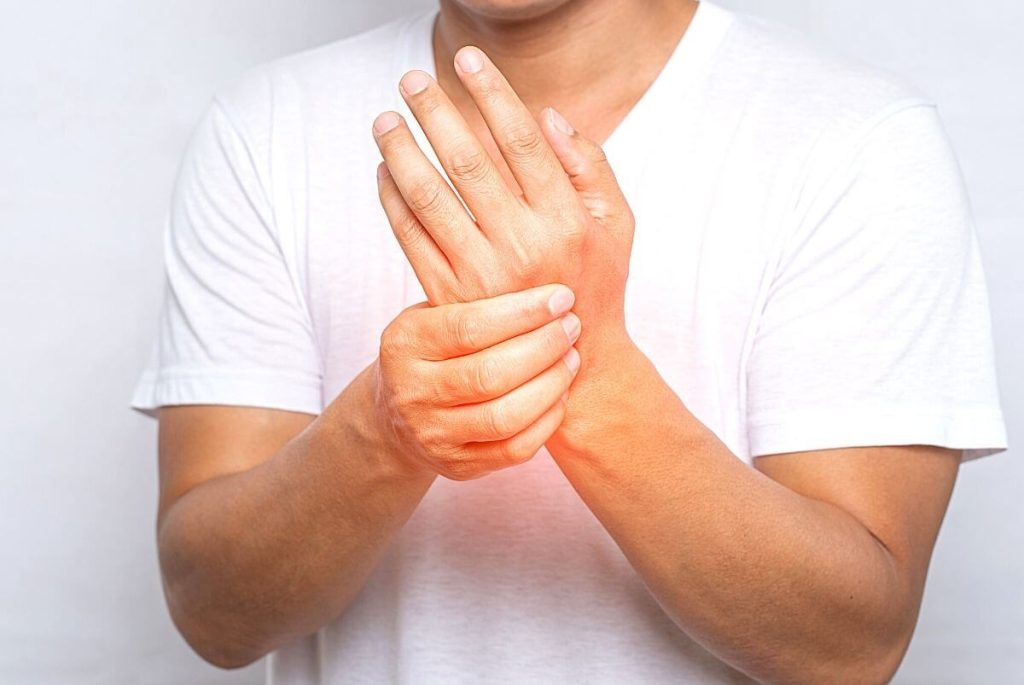Click Here for immediate access to Jonathan Brender’s Secrets
Arthritis can be described as a disease causing painful inflammation and stiffness of the joints. It can affect one joint or multiple joints. There are more than 100 different types of arthritis, with different causes and treatment methods, but the common ones are: Osteoarthritis (OA), rheumatoid arthritis (RA), psoriatic arthritis (PsA) and gout.
When Does Arthritis Develop?
The symptoms of arthritis usually develop over time, but they may also appear suddenly. The typical age for developing rheumatoid arthritis (RA) is between ages 30 and 50. It can, however, affect children, teens, and younger adults.
Osteoarthritis (OA) commonly develops after the age 50 or 60 years, but there are studies that reveal radiographic evidence of OA occurring in women in their 40s. It also tends to be more prevalent in individuals who are overweight.

Symptoms Of Arthritis
Joint pain, stiffness, and swelling are the most common symptoms of arthritis. Your symptoms may also feel worse in the morning when you get out of bed or upon standing up after you’ve been resting.
Other symptoms include:
- Limited range of motion that sometimes goes away after movement
- Muscle weakness around the joint
- Instability or buckling of the joint
- Grating or scraping feeling in the knees
- Morning stiffness that can last 30 minutes or more
- Fatigue
- Low-grade fever
- Inflammation of the eyes and mouth
- Inflammation of the heart muscle and blood vessels
- Low red blood cell count
It must be stressed that if/when left untreated, symptoms of arthritis may worsen and affect your day-to-day life.
How To Treat Arthritis
The main goal of treatment is to reduce the amount of pain you’re experiencing and prevent additional damage to the joints. You may need to try several different treatments, or combinations of treatments, before you determine what works best for you.
However, in general, the treatment for arthritis involves a combination of:
- Medications & Supplements
- Surgery
- Physical Therapy
- Lifestyle Changes – diet, exercise, weight loss
Click Here for immediate access to Jonathan Brender’s Secrets

Medications
The medications used to treat arthritis vary depending on the type of arthritis. Commonly used arthritis medications include:
- NSAIDs. Nonsteroidal anti-inflammatory drugs (NSAIDs) can relieve pain and reduce inflammation. Examples include ibuprofen (Advil, Motrin IB, others), naproxen sodium (Aleve) and Salicylates (can thin the blood, so they should not be used with additional blood thinning medications).
- NOTE: Stronger NSAIDs can cause stomach irritation and may increase your risk of heart attack or stroke. NSAIDs are also available as creams or gels, which can be rubbed on joints.
- Analgesics, such as hydrocodone (Vicodin) or acetaminophen (Tylenol), are effective for pain management, but do not help decrease inflammation.
- Menthol or capsaicin creams. These creams block the transmission of pain signals from your joints.
- Steroids, like prednisone, help reduce inflammation but should be used cautiously and for brief periods of time.
- Immunosuppressants and biologics. Immunosuppressants and biologics are prescribed for moderate to severe inflammatory arthritis like RA.
Supplements
While clinical evidence are lacking for many herbs and supplements marketed for arthritis, there are a few supplements that may be beneficial for arthritis treatment.
For example, avocado and soybean unsaponifiables (ASU) may help Osteoarthritis (OA) symptoms.
Fish oil and turmeric supplements may help reduce inflammation in rheumatoid arthritis (RA).
However, you should talk with your doctor before taking any supplements for arthritis to make sure they are safe for you and will not interact with any medications you’re currently taking.
Surgery
Surgery to replace your joint with an artificial one may be an option. This form of surgery is most commonly performed to replace hips and knees.
If your arthritis is most severe in your fingers or wrists, your doctor may perform joint fusion. In this procedure, the ends of your bones are fused, eliminating the joint and therefore eliminating the site of inflammation.
Physical therapy
Physical therapy can be helpful for some types of arthritis. Exercises can improve range of motion and strengthen the muscles surrounding joints. In some cases, splints or braces may be warranted.
Outside of your appointments, your physical therapist will likely recommend a plan of care that includes daily movement along with exercises you can complete on your own at home. Collectively, these can help build strength, flexibility, and balance to improve mobility while also preventing falls.
At-home exercises you can try include:
- The head tilt, neck rotation, and other exercises to relieve pain in your neck
- Finger bends and thumb bends to ease pain in your hands
- Leg raises, hamstring stretches, and other easy exercises for knee arthritis
Lifestyle Changes
Losing any excess weight and maintaining a moderate weight reduces the Source of developing OA and can reduce symptoms, if you already have the condition.
Eating a nutrient-dense diet is important for weight loss. Choosing a diet with lots of antioxidants, such as fresh fruits, vegetables, and herbs, can help reduce inflammation. Other inflammation-reducing foods include fish and nuts.
Foods that should be limited or avoided if you have arthritis include:
- Fried foods
- Processed foods
- Dairy products
- A high intake of meat
Regular exercise can keep your joints flexible. Swimming is often a good form of exercise for people with arthritis because it does not put pressure on your joints the way running and walking do. Staying active is important, but listening to your body when it’s signally resting and avoiding overexerting yourself are just as essential.
Click Here for immediate access to Jonathan Brender’s Secrets
References:
healthline.com
Arthritis

